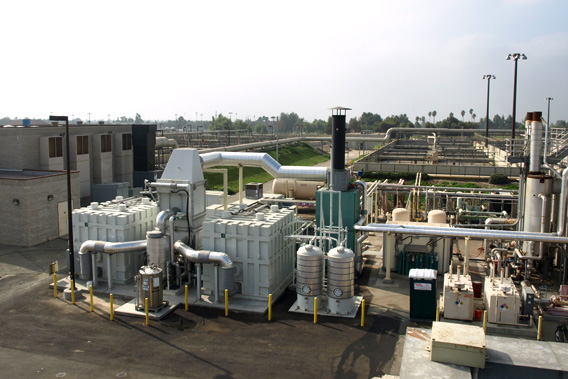Spinning Sewage into Gold
A little electrochemical magic puts power where it’s needed.
Courtesy of Nick Fontaine
The Inland Empire Utilities Agency’s Regional Water Recycling Plant No. 1 sits next to a golf course 40 miles east of downtown Los Angeles. It’s been treating wastewater from the small city of Ontario and other nearby exurbs since 1948. The plant scoops up large objects and screens out sand and gravel for disposal in a landfill, then adds and removes chemicals and nutrients before the de-poopified water is used for irrigation or discharged into nearby Cucamonga Creek. It’s an unremarkable facility, like thousands of similar ones across the United States, doing the grunt work of modern life that most people would rather not think about.
It was unremarkable, that is, until last October. On a blustery Friday, the wastewater treatment facility hooked up to a new 2.8-megawatt stationary fuel cell power plant. That’s not a great deal of electricity—enough to supply about 2,000 homes—but it’s the largest fuel-cell plant making electricity from biogas in the United States, and it now provides 60 percent of the power that Plant No. 1 had been getting from the grid.
Fuel cells solved a number of problems for the agency, all of which point to why these “distributed generation” facilities should become a growing source of electricity. These power plants make clean electricity; they make it where it’s used, obviating the need for costly, ugly and wasteful transmission lines; and they reduce or eliminate dependence on an electrical grid susceptible to occasional failure.
The treatment plant produces a lot of solid organic waste from the 44 million gallons of wastewater it processes daily. There’s an anaerobic digester on site to consume some of that waste so IEUA doesn’t have to pay to landfill everything it pulls out of the sewage, but the bacteria in the digester produce another kind of waste: methane, a potent greenhouse gas. IEUA is under the authority of the South Coast Air Quality Management District, one of the strictest such agencies in the country. Plant managers knew that beginning in November, 2012, it would be also under California’s statewide emissions trading program, forcing it, for the first time, to pay for the carbon dioxide emissions from the electricity it gets from the grid.
The fuel cells convert that liability into an asset by making electricity from the methane. Instead of burning it, as a natural gas-fueled power plant would, fuel cells complete a feat of electrochemical magic. The method was discovered almost two centuries ago but was made economical only a decade or so ago. The byproducts of the fuel cells’ activity are water and heat. The heat is fed back into the digester, keeping the bacteria at the cozy temperature that makes them happiest to eat sewage.
So: Waste from the treatment plant goes into digester, methane comes out, methane goes into fuel cell, electricity to run the treatment plant comes out, along with heat for the digester. It’s a closed-loop, carbon-neutral system supplying power and heat with virtually no greenhouse gas, particulate matter, or smog-forming chemicals. Three problems solved at once.
Initial cost to IEUA? Zero. Canada’s Anaergia Inc., using fuel cells supplied by Fuel Cell Energy Corp. of Connecticut, built the thing for free. Anaergia will get its money back over time by selling the electricity the power plant generates to IEUA.
Fuel cells have been around since 1839, when Sir William Grove reversed the known process by which an electric current splits water into hydrogen and oxygen. Grove hypothesized that if the two elements were instead combined, under the right circumstances, it would make electricity and water.
Fuel cells don’t produce much electricity on their own, so contemporary iterations pile them on top of one another. Each fuel cell is built like a sandwich; the “bread” is composed of two porous electrodes. One piece of bread produces electrons, the other consumes them. The job of the meat, cheese and vegetable layers of the sandwich is to move those electrons around the sandwich, creating the electrical circuit.
The most suitable type of fuel cell for a large generator can produce both heat and power, operate at a very high temperature, and run continuously. Plant No. 1 uses molten carbonate fuel cells with biogas as the source of hydrogen. Some of the heat and water byproduct is pulled off to make steam that’s combined with methane. The rest of the heat toasts the bacteria in the digester, or, in other applications, heats a building.
When Grove proved his hypothesis, coal was cheap and abundant, and nobody knew about the greenhouse effect, so demand for his invention was essentially nil. A hundred years later, the Hindenburg dirigible exploded over New Jersey, and combining the words “hydrogen” and “fuel” was, for a good long while, enough to blow up any business plan as surely as the Hindenburg.
